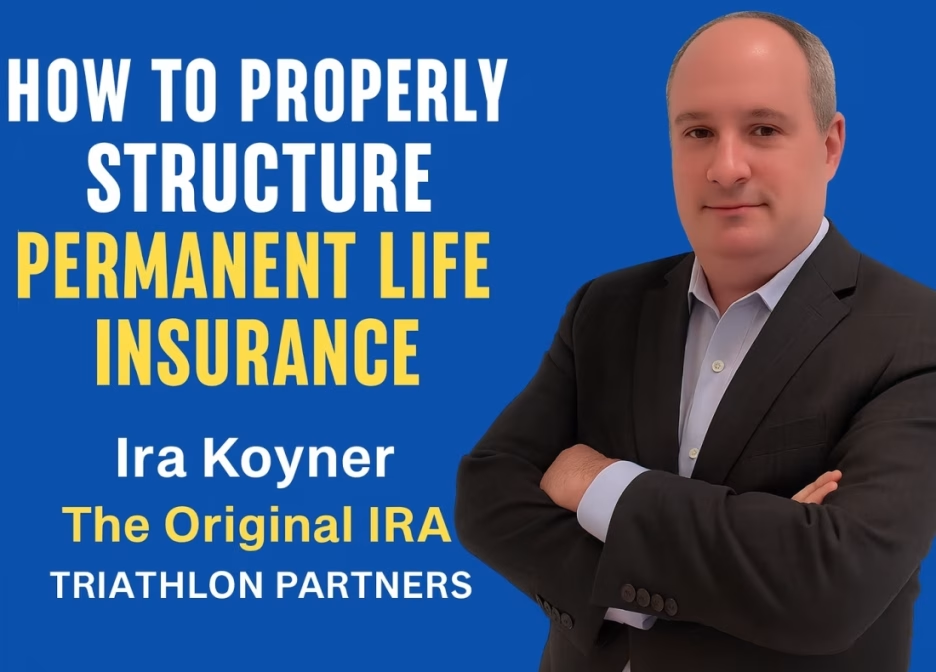Properly Structure Permanent Life Insurance How to Structure Permanent Life Insurance for Cash Value By Ira Koyner — The
Structure Permanent Life Insurance to Maximize Cash Value
- Home
- Structure Permanent Life Insurance to Maximize Cash Value

Structure Permanent Life Insurance to Maximize Cash Value
How to Structure Permanent Life Insurance for Cash Value
By Ira Koyner — The Original IRA, President of Triathlon Partners
Introduction: How to Structure Permanent Life Insurance
If you’re researching how to structure permanent life insurance, this guide explains how to maximize cash value and protect tax advantages using proven design choices. We’ll cover Indexed Universal Life cash value growth, the best IUL policy design for retirement, techniques for maximizing permanent life insurance returns, staying within non-MEC life insurance rules, building a life insurance tax-free income strategy, comparing whole life vs IUL for cash value, the benefits of an overfunded IUL policy, creating a cash value life insurance retirement plan, tailored IUL funding strategies for high net worth families, and the tax advantages of Indexed Universal Life.
Structure matters because permanent life insurance is not just a death benefit—it’s an investment-like asset. Designed correctly, it can provide Roth-like characteristics: tax-deferred growth and the potential for tax-free access when managed properly.
Watch Ira Koyner explain the full strategy in this video:
Whole Life vs IUL for Cash Value
Whole life offers guarantees and fixed premiums, but often at the cost of flexibility and higher access charges. Indexed Universal Life (IUL) typically offers flexible funding, index-linked crediting with floors, and more liquidity control—key features for accumulation-focused designs.
Best IUL Policy Design for Retirement
The best designs prioritize flexible premium funding, competitive crediting strategies (e.g., annual point-to-point with a 0% floor and caps or participation rates), and efficient policy charges. Carrier selection, loan provisions, and service quality also matter for long-term success.
Maximizing Permanent Life Insurance Returns
Returns hinge on directing the highest possible share of each premium into cash value—by minimizing the required death benefit (within IRS rules) and controlling costs. Annual reviews help keep allocations aligned with market conditions and your objectives.
Non-MEC Life Insurance Rules
The IRS limits how much premium you can pay relative to the policy’s death benefit. Exceeding those limits creates a Modified Endowment Contract (MEC), which undermines tax-free access. Designing to the minimum non-MEC death benefit for your planned premium is essential for maximizing accumulation potential.
Life Insurance Tax-Free Income Strategy
A common approach is to withdraw to basis and then use policy loans for additional income—managed prudently to maintain policy health. Coordination with a knowledgeable advisor is critical to monitor loan interest, prevent lapse, and preserve tax advantages.
Overfunded IUL Policy Benefits
Overfunding (while staying non-MEC) front-loads cash value, amplifies compounding, and can shorten the required funding period. This can increase flexibility later—often allowing premiums to be reduced or stopped while keeping the policy on track.
Cash Value Life Insurance Retirement Plan
When integrated into a broader retirement plan, cash value can serve as a volatility buffer, a tax-advantaged income source, and a legacy tool. Proper structure allows coordinated withdrawals that complement other assets like brokerage accounts, qualified plans, and Roth IRAs.
IUL Funding Strategies for High Net Worth
High earners often prefer front-loading or large early contributions to maximize long-term growth, provided non-MEC limits are respected. Alternative patterns include predictable level funding or a single large contribution with careful design to maintain flexibility.
Tax Advantages of Indexed Universal Life
IUL can offer tax-deferred growth, potential tax-free access, and no statutory contribution limits—features that make it attractive as a complement to traditional retirement vehicles. Policy costs, risks, and carrier stability still require careful evaluation.
Putting Structure to Work: A Simple Example
Assume a 25-year-old contributes $10,000 annually for 30 years. With identical carrier and crediting assumptions, a design using the minimum non-MEC death benefit may accumulate substantially more cash value than a higher-death-benefit design, because a larger share of each premium goes toward growth rather than insurance cost.
Life Insurance Policy Review
Already own a permanent policy? You’ve made the decision—now ensure it’s optimized. A professional review can identify opportunities to reduce costs, improve allocation, refine loan provisions, and align funding with your long-term income goals.
Get a Free Policy Review
Ready to optimize your design? Contact Triathlon Partners for a complimentary review with Ira Koyner, The Original IRA. We’ll evaluate your structure, funding approach, and carrier features to help you pursue maximum long-term value.
Category
- Annuities(9)
- Business Solutions(4)
- Charitable Giving(1)
- Financial Planning(21)
- Insurance(18)
- Market Commentary(8)
- Structured Notes(14)
- TriathlonPartnersTV(37)

